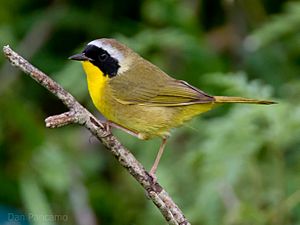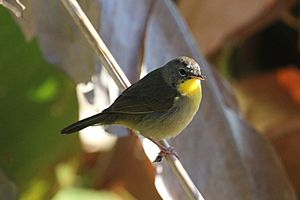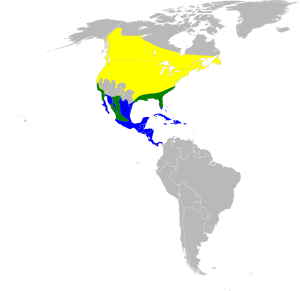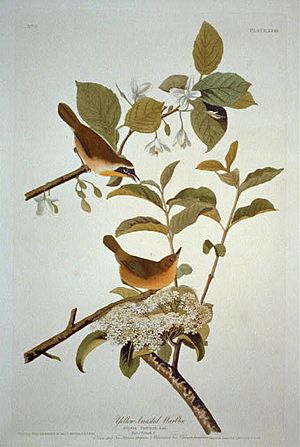Common yellowthroat facts for kids
Quick facts for kids Common yellowthroat |
|
|---|---|
 |
|
| Male | |
 |
|
| Female | |
| Conservation status | |
| Scientific classification | |
| Genus: |
Geothlypis
|
| Species: |
trichas
|
 |
|
| Range of G. trichas Breeding range Year-round range Wintering range | |
| Synonyms | |
|
Turdus trichas Linnaeus, 1766 |
|
The common yellowthroat (Geothlypis trichas) is a small, lively bird. It is a type of New World warbler. These birds are very common in North America. You can find them from southern Canada to central Mexico.
The scientific name, Geothlypis trichas, comes from Ancient Greek words. Geo means "ground," and thlupis was a name for a small bird. The word trichas means a type of thrush.
Contents
What Do They Look Like?
Common yellowthroats are small songbirds. They have olive-colored backs, wings, and tails. Their throats and chests are bright yellow. Their bellies are white.
Adult males have a special black mask. This mask goes from the sides of their neck, across their eyes, and over their forehead. A white or gray stripe borders the top of this black mask.
Females look a lot like males. However, their yellow parts are paler. They also do not have the black mask. Young birds look similar to the adult female. First-year males have a faint black mask. This mask gets darker by spring.
There are 13 different kinds, or races, of this bird. These races mostly differ in the male's face pattern. They also differ in how bright their yellow parts are. The birds found in the southwestern parts of their range are the brightest yellow.
Size and Weight
- Length: 4.3 to 5.1 inches (11 to 13 cm)
- Weight: 0.3 to 0.3 ounces (9 to 10 g)
- Wingspan: 5.9 to 7.5 inches (15 to 19 cm)
Where Do They Live and What Do They Do?
Common yellowthroats like to live in wet areas. These include marshes and places with thick, low plants. They can also be found in other areas with dense bushes. They are less common in dry places.
These birds build cup-shaped nests in low plants. Females lay 3 to 5 eggs. Both parents help feed the young birds.
Birds from northern areas fly south for winter. They are night migrants. They spend winter in the southern parts of their breeding range. Some go to Central America or the West Indies. Birds from southern areas usually stay in the same place all year.
Common yellowthroats eat insects. They usually catch insects in thick plants. Sometimes, they catch them while flying.
The common yellowthroat's song is loud. It sounds like twichety twichety twichety twich. Their call is a soft jip.
How Many Are There?
The number of common yellowthroats has gone down in some areas. This is because they have lost their favorite places to live. However, this bird is still very common overall.
Their Amazing Journeys: Migration
Common yellowthroats travel long distances. This journey is called migration. Their travel routes change depending on the season.
In the fall, from August to October, they fly south. Birds from Canada and different parts of the U.S. have their own routes. All adult and young birds tend to arrive at their winter homes around the same time.
In the spring, from early February to late May, they fly north. Males usually arrive at their breeding spots before the females. This might help males find good territories first.
During both fall and spring migration, many birds take breaks. These breaks are called "stopover periods." Some birds rest for a few days. Others might stay for several weeks or even months. Then they continue their journey.
Scientists have studied common yellowthroat migration in places like Appledore Island, Maine. They found that males arrive earlier than females. They also weigh more when they arrive. Both male and female birds usually stay on the island for about a week before flying on.
In Florida, common yellowthroats are seen more in the southern part. The busiest time for migration there is from late September to mid-October. More studies are needed to learn about their migration in other areas.
See also
 In Spanish: Mascarita común para niños
In Spanish: Mascarita común para niños




